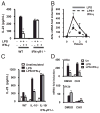Cutting edge: IFN-gamma is a negative regulator of IL-23 in murine macrophages and experimental colitis
- PMID: 20228197
- PMCID: PMC2956738
- DOI: 10.4049/jimmunol.0903600
Cutting edge: IFN-gamma is a negative regulator of IL-23 in murine macrophages and experimental colitis
Abstract
IL-23 regulation is a central event in the pathogenesis of the inflammatory bowel diseases. We demonstrate that IFN-gamma has anti-inflammatory properties in the initiation phase of IL-23-mediated experimental colitis. IFN-gamma attenuates LPS-mediated IL-23 expression in murine macrophages. Mechanistically, IFN-gamma inhibits Il23a promoter activation through altering NF-kappaB binding and histone modification. Moreover, intestinal inflammation is inhibited by IFN-gamma signaling through attenuation of Il23a gene expression. In germ-free wild-type mice colonized with enteric microbiota, inhibition of colonic Il23a temporally correlates with induction of IFN-gamma. IFN-gammaR1/IL-10 double-deficient mice demonstrate markedly increased colonic inflammation and IL23a expression compared with those of IL-10(-/-) mice. Colonic CD11b(+) cells are the primary source of IL-23 and a target for IFN-gamma. This study describes an important anti-inflammatory role for IFN-gamma through inhibition of IL-23. Converging genetic and functional findings suggest that IL-23 and IFN-gamma are important pathogenic molecules in human inflammatory bowel disease.
Conflict of interest statement
The authors have no financial conflicts of interest.
Figures




Similar articles
-
Characterization of an interferon-stimulated response element (ISRE) in the Il23a promoter.J Biol Chem. 2011 Jan 14;286(2):1174-80. doi: 10.1074/jbc.M110.147884. Epub 2010 Nov 21. J Biol Chem. 2011. PMID: 21097874 Free PMC article.
-
A cell permeable peptide inhibitor of NFAT inhibits macrophage cytokine expression and ameliorates experimental colitis.PLoS One. 2012;7(3):e34172. doi: 10.1371/journal.pone.0034172. Epub 2012 Mar 27. PLoS One. 2012. PMID: 22479554 Free PMC article.
-
Activation of the epidermal growth factor receptor in macrophages regulates cytokine production and experimental colitis.J Immunol. 2014 Feb 1;192(3):1013-23. doi: 10.4049/jimmunol.1300133. Epub 2014 Jan 3. J Immunol. 2014. PMID: 24391216 Free PMC article.
-
Innate PI3K p110δ regulates Th1/Th17 development and microbiota-dependent colitis.J Immunol. 2014 Apr 15;192(8):3958-68. doi: 10.4049/jimmunol.1301533. Epub 2014 Mar 14. J Immunol. 2014. PMID: 24634494 Free PMC article.
-
Clostridium difficile infection aggravates colitis in interleukin 10-deficient mice.World J Gastroenterol. 2014 Dec 7;20(45):17084-91. doi: 10.3748/wjg.v20.i45.17084. World J Gastroenterol. 2014. PMID: 25493020 Free PMC article.
Cited by
-
Transient receptor potential ankyrin1 channel is endogenously expressed in T cells and is involved in immune functions.Biosci Rep. 2019 Sep 20;39(9):BSR20191437. doi: 10.1042/BSR20191437. Print 2019 Sep 30. Biosci Rep. 2019. PMID: 31488616 Free PMC article.
-
NFIL3 is a regulator of IL-12 p40 in macrophages and mucosal immunity.J Immunol. 2011 Apr 15;186(8):4649-55. doi: 10.4049/jimmunol.1003888. Epub 2011 Mar 7. J Immunol. 2011. PMID: 21383239 Free PMC article.
-
New perspectives on the ligands and function of the killer cell immunoglobulin-like receptor KIR3DL2 in health and disease.Front Immunol. 2012 Nov 16;3:339. doi: 10.3389/fimmu.2012.00339. eCollection 2012. Front Immunol. 2012. PMID: 23162554 Free PMC article.
-
Butyrate suppresses colonic inflammation through HDAC1-dependent Fas upregulation and Fas-mediated apoptosis of T cells.Am J Physiol Gastrointest Liver Physiol. 2012 Jun 15;302(12):G1405-15. doi: 10.1152/ajpgi.00543.2011. Epub 2012 Apr 19. Am J Physiol Gastrointest Liver Physiol. 2012. PMID: 22517765 Free PMC article.
-
Cholecystokinin octapeptide (CCK-8): friend or foe for rheumatoid arthritis?Rheumatol Int. 2011 Oct;31(10):1397-8. doi: 10.1007/s00296-010-1582-3. Epub 2010 Jul 29. Rheumatol Int. 2011. PMID: 20668859 No abstract available.
References
-
- Xavier RJ, Podolsky DK. Unravelling the pathogenesis of inflammatory bowel disease. Nature. 2007;448:427–434. - PubMed
-
- Uhlig HH, McKenzie BS, Hue S, Thompson C, Joyce-Shaikh B, Stepankova R, Robinson N, Buonocore S, Tlaskalova-Hogenova H, Cua DJ, Powrie F. Differential activity of IL-12 and IL-23 in mucosal and systemic innate immune pathology. Immunity. 2006;25:309–318. - PubMed
-
- Cho JH. The genetics and immunopathogenesis of inflammatory bowel disease. Nat Rev Immunol. 2008;8:458–466. - PubMed
-
- Harrington LE, Hatton RD, Mangan PR, Turner H, Murphy TL, Murphy KM, Weaver CT. Interleukin 17-producing CD4+ effector T cells develop via a lineage distinct from the T helper type 1 and 2 lineages. Nat Immunol. 2005;6:1123–1132. - PubMed
-
- Zhu C, Rao K, Xiong H, Gagnidze K, Li F, Horvath C, Plevy S. Activation of the murine interleukin-12 p40 promoter by functional interactions between NFAT and ICSBP. J Biol Chem. 2003;278:39372–39382. - PubMed
Publication types
MeSH terms
Substances
Grants and funding
LinkOut - more resources
Full Text Sources
Other Literature Sources
Molecular Biology Databases
Research Materials

